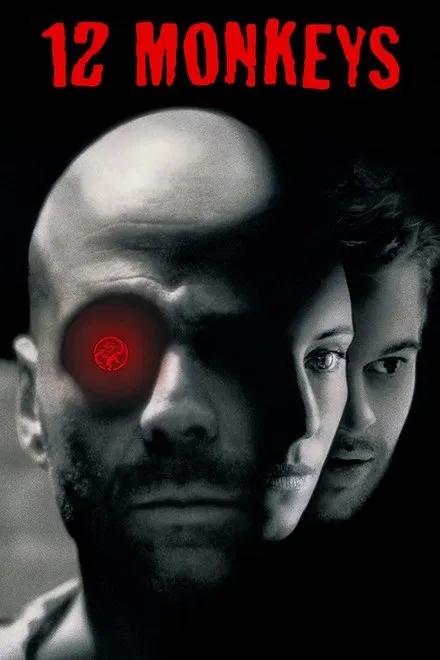
Directed by: Terry Gilliam
Starring: Bruce Willis, Madeleine Stowe, Brad Pitt, Christopher Plummer, David Morse
🧠 Introduction: Apocalypse and the Prison of Memory
12 Monkeys (1995), directed by Terry Gilliam, is a fever dream of a film that explores the trauma of apocalypse, the unreliability of memory, and the tragic futility of changing the past. Loosely inspired by Chris Marker’s short film La Jetée, it stars Bruce Willis as James Cole, a convict from a post-apocalyptic future sent back in time to prevent a deadly pandemic. The film’s twisty, recursive structure serves both as narrative engine and psychological trap.
🌪️ Madness and the Fragmented Self
Cole’s journey through time is marked by institutionalization, confusion, and repeated doubts about his own sanity. The film blurs the line between genuine time travel and delusion: is Cole a savior, or simply a madman trapped in his own broken memories? Gilliam’s direction is claustrophobic and hallucinatory—distorted camera angles, surreal architecture, and frantic editing reinforce the instability of Cole’s perceptions.
Brad Pitt’s Jeffrey Goines embodies chaos, both as anarchic revolutionary and as an emblem of society’s own irrationality. The supporting characters oscillate between helpers and obstacles, each reflecting different facets of Cole’s struggle to hold onto reality.
⏳ The Tragedy of Time: Causality and Predestination
The film’s most haunting twist is its embrace of causal determinism. The childhood memory that haunts Cole—a man’s death in an airport—turns out to be the memory of his own death, witnessed by his younger self. Every attempt to change the past only fulfills it; the apocalypse cannot be averted because it is already written into the fabric of time. The viral outbreak is inevitable, and human agency is revealed as an illusion.
This closed-loop structure is mirrored in the film’s visual and narrative motifs: spirals, repeating images, and déjà vu. The audience is left to grapple with the possibility that all history is preordained, and that meaning can only be found in the courage to act despite certain failure.
💡 Memory, Love, and the Ghosts of the Future
At its core, 12 Monkeys is about the persistence of memory and the yearning for connection in a ruined world. Cole’s relationship with Dr. Kathryn Railly (Madeleine Stowe) offers moments of tenderness amid the chaos. Their doomed romance serves as an anchor, a reminder of what is worth saving—even if salvation is impossible.
The film resists the cynicism of pure determinism by foregrounding the small acts of kindness, courage, and empathy that punctuate the nightmare. In a universe where nothing can be changed, the only freedom lies in how one responds to suffering.
🎯 Final Thoughts: Madness as Clarity
12 Monkeys remains one of the most resonant time travel films, not for its puzzle-box plot, but for its willingness to embrace the madness, ambiguity, and tragedy of human existence. Its twist ending is less a shock than a confirmation: history is a labyrinth, and we are all condemned to wander its halls, haunted by memories of what might have been.